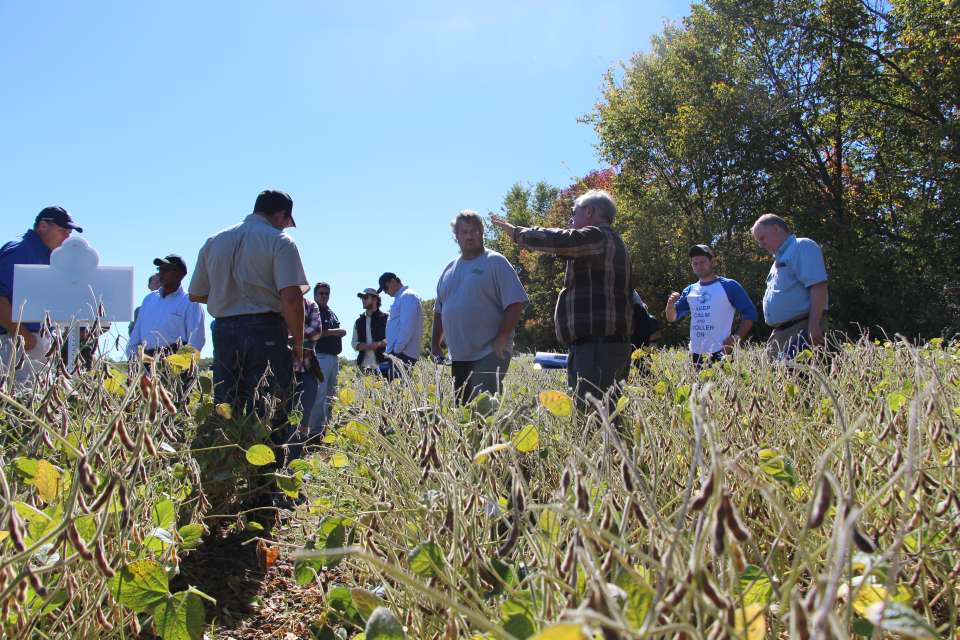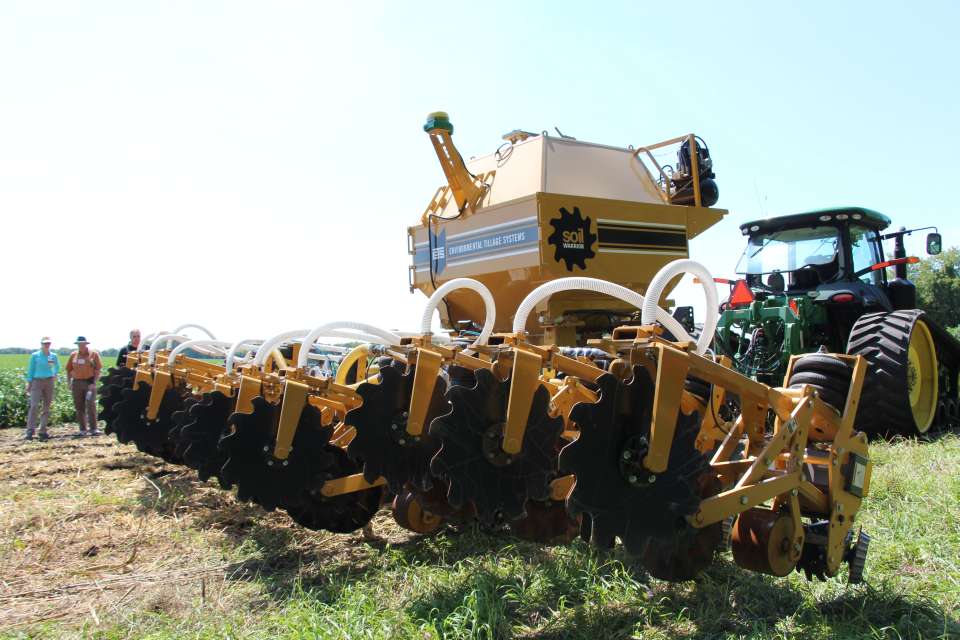Nutrient Stewardship: Selling Growers Still Key For Adoption

Retailers remain in solid position to continue to help move more acres into nutrient stewardship mode in 2016. Pictured: Growers looking at soybeans in an Ohio field.
Although his brother is more on the fertilizer side of the family business and he on the seed side, Kris Ehler, Co-Owner, Ehler Brothers Seed, Thomasboro, IL, remains out on the front lines of nutrient stewardship efforts, making recommendations to growers and drawing up nutrient management plans throughout the season.
“For the last couple years we’ve been doing urea — but we’ve got an airflow urea (applicator) — so it’s not broadcast,” said Ehler during a brief chat at Commodity Classic 2016. “And we’re maxed out on acres on that thing every year.
“The other thing that we’re doing is Triple Superphosphate, we’re eliminating the nitrogen portion on the fall applied — so moving those nitrogen units to a spring-applied situation. Anytime you move that nitrogen application closer to when the crop needs it, the less chance you have of it ending up in a water source.”
Ehler Brothers, like any forward-thinking retailer, is hoping to stay out in front of the coming regulatory storm that could (and likely will) dramatically shift cultural practices around fertilizer application in the near future.
“Today, you’ve got to have a nutrient management plan, and we see it coming — it’s going to be regulated at some point, so as retailers we want to self-regulate before it gets to that point,” Ehler explained. “It’s probably going to come down to a CCA-type deal. The other thing I see is these big data companies — Climates, Agribles, FarmLogs — all have these nutrient prescription programs, it just adds another layer.”
Going forward, Ehler says he and his brother are looking at adding a custom nitrogen sidedress bar to the operation.
“If a guy has to split up his nitrogen, he’s probably not going to do it himself, so that’s just another thing we’ve got to get out in front of for our customers.”
Selling Sustainability
In an absolutely idyllic world, every single grower would whole-heartedly embrace nutrient stewardship with open arms. Yet, for all we know, there are still some growers out there that need a little convincing from their trusted advisor and other industry stakeholders.
Enter Galynn Beer, AgroLiquid Senior Sales Manager, who spends a significant chunk of time each year training the sales force at the St. Johns, MI-based plant nutrient formulator to speak to growers about nutrient stewardship.
“I’m with one of our sales guys now and we just try to make sure that we’re consistently giving correct stories, correct facts to the farmer, and we’re always trying to recommend things in a way that benefits him,” Beer says. “We’re actually looking at a soil test right now, and we’re seeing ‘Okay, this guy needs manganese, he needs phosphorus,’ so we know that it helps us to be able to understand that and help build that picture and help the farmer spend his money correctly.”

The Soil Warrior Tillage Tool can be used for nutrient management.
Beer is seeing solid adoption of nutrient stewardship practices throughout AgroLiquid’s trade territories — chief among them being split nitrogen application and strip tillage.
“Some of the nutrient stewardship practices that are gaining popularity are banding, and another one of those is actually strip tillage,” Beer explains. “I mean, I feel like strip till is one of those management practices that continues to grow because it kind of allows a farmer to build a nice seed bed and place some nutrients where they are most accessible by the plant.
“Another nutrient practice that out of necessity is becoming popular is multiple (a.k.a.; split) applications of nitrogen. Just trying to make sure that we’re monitoring how much nitrogen we need through tissue testing and soil testing and then making sure that we are applying that multiple times just to avoid it moving to the unwanted destinations like waterways.”
Economic benefits have made the switch to split applied nitrogen a little easier on farmer’s psyche, according to Beer.
“Most people have bought into the split apply, and part of that is fertilizer prices over time — and yes, I realize they’ve come down this year — but still, compared to 20 years ago when I remember getting a pound of nitrogen for 10 or 12 cents, and now in today’s market it’s roughly four times that much,” he says. “Guys aren’t willing to risk losing that. Part of it is the noble cause of being good to the environment, but economics weigh heavily on making sure that they put it out there and get it utilized, because they are paying more for those nutrients than they used to.”
One area that Beer thinks is going to remain key for farmers going forward is to maintain soil testing programs.
“We really have encouraged through this tighter economic market that guys be prudent with how they spend their money,” he says. “It’s easy for guys to go ‘You know what, I’m going to skip a soil test this year,’ and really a soil test is probably one of the best investments they can make in this market because we can decide exactly what we need to prioritize, what they need to spend money on, and we can be more crop-specific with it.”
Beer points to zinc applications on corn and manganese on soybeans as two practices that soil test data have confirmed a solid return on investment for the grower.
“We really recommend that guys — while they might have a tendency to pull back from soil testing — that they actually be more diligent with soil testing and allowing their suppliers to see that whole picture, and do the best job they can.”






